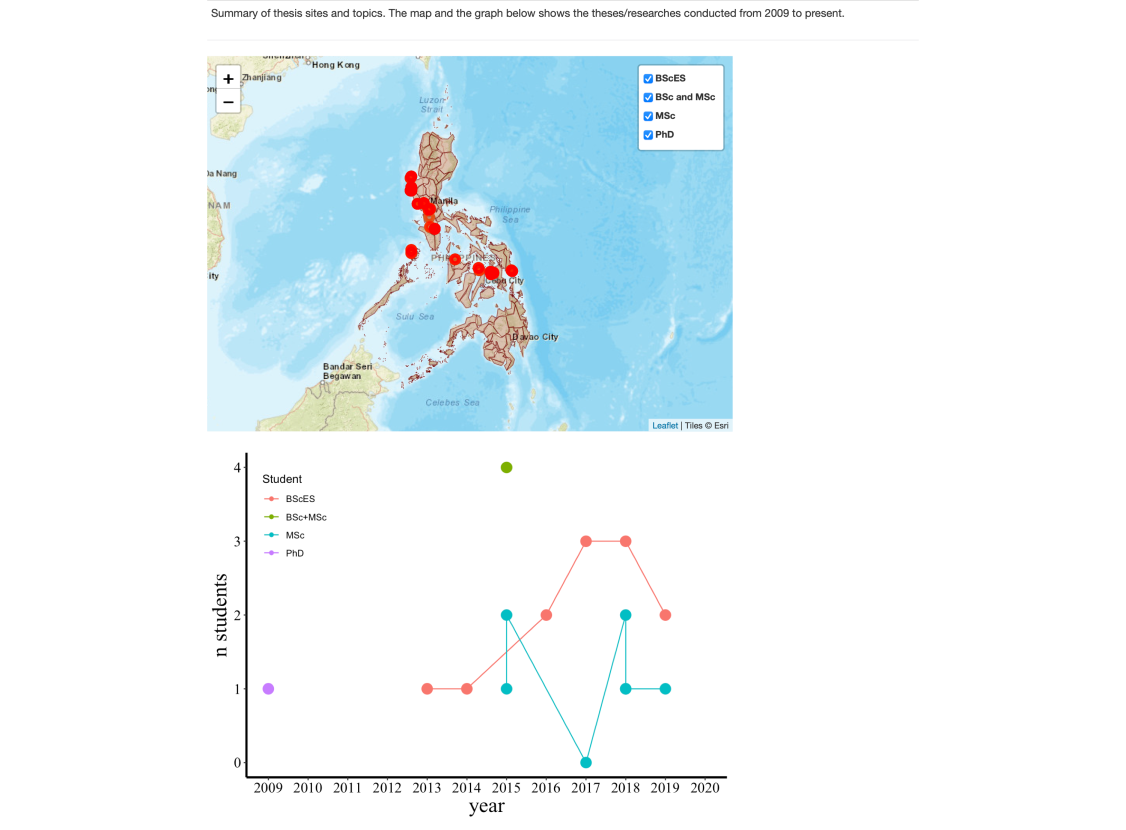Project Summary (please click the map for more site-specific details).
Topics: biodiversity; habitat connectivity (seascape ecology), carbon sequestration, surface elevation change, mangrove colonization and heavy metal accumulation/stabilization.
Disturbance assessed: typhoon, earthquake, lahar, coral bleaching, habitat conversion, coastal development/reclamation, urbanization, tourism, and heavy metal/mining contamination.
N is the number of sites (and/or sampling plots)

Comparative Seascape Blue Carbon Assessment in Conserved vs. Disturbed Seagrass in Masinloc, Zambales (University Research Council, AdMU; June 2019 – May 2020)

Enhancement of Philippines’ research capability in understanding the role of mangrove ecosystem health in the adaptation and mitigation against natural disasters (September 2014 – January 2018)
This project aims to establish a greater understanding of mangrove adaptation to natural disasters in the Philippines and to improve the capacity of Filipino researchers in monitoring coastal systems. We will pursue the aims of the project by conducting an assessment of the stability (or instability) of disturbed, restored, and intact mangroves in response to typhoons and sea level rise. The project will be conducted in northern Luzon plus mangrove areas that were hit by Super Typhoon Haiyan in western Luzon, and central and eastern Visayas. The study will investigate the geomorphological, and biological processes that contribute to the capacity of mangroves to keep pace with sea level rise and its implication for landscape change and sequestration of carbon.

Influence of mangrove biodiversity on accumulation of carbon and resilience to sea-level rise: A comparative assessment among disturbed, restored, and intact mangrove systems (June 2014 – December 2016).
The project seeks to promote a common methodology across the region to attain a regional understanding of the relationship of vulnerability to sea level rise and carbon sequestration with mangrove diversity. The research will provide data, knowledge and tools that can be used for enhancing the design of mangrove restoration programs to become more resilient with the impacts of projected sea level rise and to enhance carbon sequestration. Results of the study will be used in making landscape models (e.g. sea level affects marshes model) that will enable the development of links between science and policy.

1st State of the Mangrove Summit – Northwestern Luzon (September – December 2014)
This project is funded by the Foundation for the Philippine Environment in partnership with the Biodiversity Management Bureau of DENR and Conservation International – Philippines. The summit envisions institutionalizing a national State of the Mangrove biannual workshop that consolidates mangrove status and monitoring data (growth, biodiversity, etc.). This information, collated in an accessible database, will also be useful in estimating the carbon sequestration capacity and assessing the vulnerability of mangroves against sea level rise.

CHED through the Philippine Higher Education Research Network (PHERNet) Program
Assessing the success of mangrove rehabilitation projects in Northern Luzon, Philippines: Comparative rate of carbon deposition in natural versus planted mangrove stands (January 2013 – June 2016).
The study will provide a rare opportunity to understand the dynamics and trajectory of developing mangroves from a degraded system, and compare it with natural mangroves. It will provide critical understanding on the importance of, and inherent ecosystem dynamics in, restoration ecology. It will contribute to the generation of knowledge in understanding how ‘barren’ areas planted with mangroves might, over two decades, be changed and improved in terms of forest vegetation structure and productivity and estimate its contribution in sequestering atmospheric CO2. By measuring impacts, mangrove managers will realize how long, and at what extent, would planted mangroves perform at certain ages, and how much is being loss or miss when natural mangroves are converted into other uses.

Mangroves of the Philippines: Responding to Environmental and Social Change (in collaboration with Prof. Miguel Fortes of UP Marine Science Institute; June 2013 – December 2014)
This project aims to produce a book about Philippine mangroves. The book presents one of the most comprehensive studies on mangroves in the Philippines. Historical changes in the country’s mangroves and their use were examined in 875 published accounts for 1698-2014, a period of 316 years. The primary purpose of this book is to effect a positive change in mangrove and coastal policies and actions in order to reduce the long-term negative consequences on the ecosystem’s integrity. Hence, we cater to the needs for knowledge and action of people with a wide range of educational backgrounds (from graduates of secondary to post-graduate higher degrees) and professional careers (government and private project staff to coastal resources entrepreneurs and top-level policy makers) who influence decisions on the fate of mangroves as a vital human capital.

